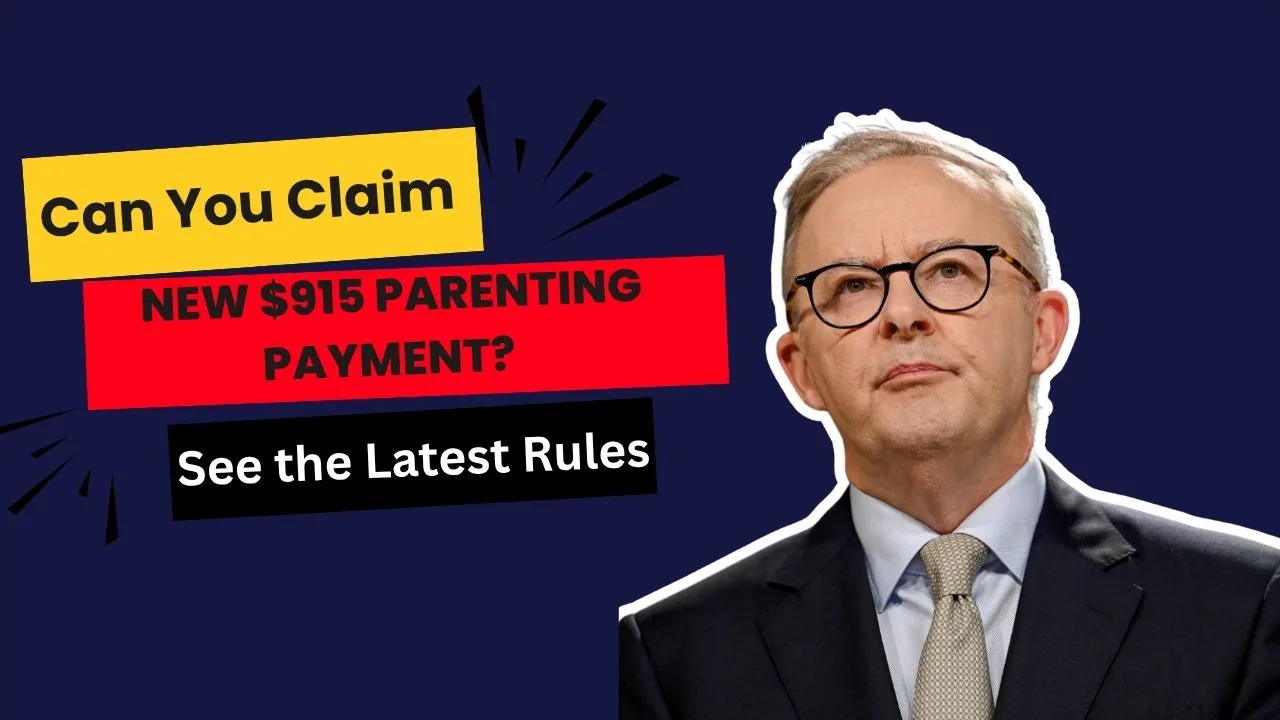Raising children is a rewarding yet financially demanding responsibility. In Australia, the Centrelink Parenting Payment serves as a lifeline for low-income parents and guardians, helping them manage the costs of raising young children. As of February 2025, eligible single parents can receive up to $915 per fortnight, while partnered parents may qualify for up to $718.10. This article provides a comprehensive guide to the latest eligibility rules, application process, payment schedules, and additional support available for the Parenting Payment in 2025. Whether you’re a single parent or part of a couple, understanding these rules can make a significant difference in your financial planning.
What is the Parenting Payment?
The Parenting Payment is a government-funded financial support program administered by Services Australia through Centrelink. It is designed to assist low-income parents and guardians who are the primary caregivers of young children. The payment aims to alleviate financial stress, allowing parents to focus on nurturing their children during critical early developmental years. It covers essential expenses such as food, clothing, education, childcare, and housing, helping families maintain stability in the face of rising living costs.
In 2025, the Parenting Payment remains a cornerstone of Australia’s social security system, reflecting the government’s commitment to supporting families. The payment is disbursed fortnightly, ensuring consistent support, and is adjusted biannually in March and September to account for inflation and economic changes. For single parents, the maximum payment is $915 per fortnight, which may include supplements like Rent Assistance and Energy Supplement. Partnered parents can receive up to $718.10, depending on their household income and assets.
Eligibility Criteria for the $915 Parenting Payment
To qualify for the Parenting Payment in 2025, applicants must meet specific criteria set by Services Australia. These rules ensure the payment reaches families with the greatest need, particularly those with young children and limited income. Below are the key eligibility requirements:
1. Primary Caregiver Status
You must be the principal carer of a dependent child, responsible for their day-to-day care, welfare, and development. Only one parent or guardian in a household can claim the Parenting Payment at a time. If one partner is already receiving it, the other is ineligible.
2. Child Age Requirements
-
Single Parents: Your youngest child must be under 8 years old. However, some sources indicate that single parents may remain eligible until their youngest child turns 14, particularly if the child is still in school or if the parent meets specific circumstances, such as studying or limited employment.
-
Partnered Parents: Your youngest child must be under 6 years old. This ensures the payment targets families with the most intensive caregiving responsibilities during early childhood.
3. Residency Requirements
Applicants must be Australian citizens, permanent residents, or hold an eligible visa and have lived in Australia for at least 12 months. You must also be physically present in Australia when applying. Exceptions may apply for refugees or humanitarian entrants.
4. Income and Assets Tests
Your eligibility and payment amount depend on your (and your partner’s, if applicable) income and assets. The income test considers all earnings, including wages, business profits, investments, and other government benefits. For single parents, payments begin to reduce if income exceeds $220.60 per fortnight and phase out completely if income exceeds $2,796.35 per fortnight. For partnered parents, the combined household income is assessed, with thresholds varying based on family size and circumstances.
The assets test evaluates wealth, including savings, vehicles, investment properties, and shares, but excludes the primary family home. If your assets exceed Centrelink’s thresholds (which differ for homeowners and non-homeowners), your payment may be reduced or denied. For the latest income and asset thresholds, visit the Services Australia website.
5. Mutual Obligation Requirements
Depending on your circumstances, you may need to meet mutual obligation requirements, such as participating in approved activities (e.g., job-seeking, training, or parenting programs). Single parents with children under 6 are generally exempt from these requirements, but those with older children may need to engage in part-time work or study.
6. Additional Notes
-
You cannot claim the Parenting Payment before your child is born.
-
If you receive certain payments from the Department of Veterans’ Affairs (DVA), you may be ineligible.
-
Foster parents may qualify if they are the primary carer of a dependent child under the age limit.
How to Apply for the Parenting Payment
Applying for the Parenting Payment is straightforward and can be done through multiple channels. Here’s a step-by-step guide to ensure a smooth application process:
-
Create or Access a myGov Account: Visit myGov and set up an account if you don’t have one. If you already have an account, log in and link it to Centrelink using your Customer Reference Number (CRN).
-
Gather Required Documents: Prepare proof of identity (e.g., passport, driver’s license, Medicare card), proof of income (e.g., payslips, tax returns, bank statements), and your child’s birth certificate or proof of birth.
-
Submit Your Claim: Navigate to the “Payments and Claims” section on the myGov portal, select “Make a Claim,” and choose “Parenting Payment.” Complete the application form, ensuring all information is accurate.
-
Upload Documents: Upload the required documents and submit your claim. Double-check for accuracy to avoid delays.
-
Monitor Your Application: Centrelink typically processes claims within 14 days. Check your myGov inbox for updates or requests for additional information.
Alternatively, you can apply by calling Centrelink at 13 24 68 or visiting a Centrelink office in person. For rural or remote families, additional support channels are available. Once approved, your first payment will typically arrive within two weeks, deposited directly into your nominated bank account.
Payment Schedules for February 2025
Parenting Payments are disbursed fortnightly, with exact dates varying based on your individual circumstances. For February 2025, payments are expected to follow the standard Centrelink schedule, but if a payment date falls on a public holiday, funds may be deposited on the next business day. To find your specific payment dates, log into your myGov account or use the Centrelink Express Plus app. Regularly checking your payment status ensures you stay informed and can plan your finances effectively.
Additional Support for Families
Eligible recipients of the Parenting Payment may also qualify for supplementary benefits to further ease financial pressures. These include:
-
Rent Assistance: Helps with housing costs for families renting in the private market or community housing. Eligibility is automatically assessed when you apply for the Parenting Payment.
-
Energy Supplement: Provides support for rising electricity and gas costs.
-
Family Tax Benefit: Offers financial assistance for the cost of raising children, with amounts varying based on income and family size.
-
Child Care Subsidy: Reduces childcare costs for working or studying parents, with payments made directly to childcare providers.
-
Parent Pathways: A voluntary support service offering tailored advice, mentoring, and resources to help parents achieve future goals.
To explore these benefits, visit the Services Australia payments for families page. Combining these supports with the Parenting Payment can significantly enhance your financial stability.
Common Mistakes to Avoid
To ensure a smooth application process and avoid delays or overpayments, be mindful of these common errors:
-
Incomplete Documentation: Failing to provide all required documents, such as proof of income or your child’s birth certificate, can delay processing.
-
Not Reporting Changes: You must promptly report changes in income, relationship status, or residency to Centrelink. Failure to do so may result in overpayments, which you’ll need to repay.
-
Missing Deadlines: Late applications can delay your first payment. Apply early and monitor your myGov inbox for updates.
Financial advisors recommend using the Parenting Payment strategically, such as allocating funds toward high-priority needs like education, healthcare, or emergency savings. Practicing disciplined budgeting can maximize the payment’s impact and contribute to long-term financial security.
Real-Life Impact of the Parenting Payment
The $915 Parenting Payment is more than just financial aid—it’s a lifeline for many Australian families. For example, consider Jane, a single mother of two in Sydney. After transitioning to part-time work, Jane struggled to cover rent and school supplies. The Parenting Payment allowed her to stabilize her finances, afford quality childcare, and enroll in a part-time course to upskill. Similarly, Aditya and Maria, a young couple in a regional town, used the payment to manage childcare costs, enabling them to maintain a balanced home life while working part-time.
These stories highlight the payment’s role in restoring dignity and control to caregivers. By providing consistent support, the Parenting Payment helps families navigate economic challenges and invest in their children’s future.
FAQs
1. Is the Parenting Payment taxable?
Yes, the Parenting Payment is considered taxable income and must be included in your annual tax return. Consult a tax professional for guidance on how it affects your tax obligations.
2. Can I receive the Parenting Payment while studying?
Yes, you may still be eligible if you meet all other criteria, including income and assets tests. Studying may also exempt you from certain mutual obligation requirements, depending on your circumstances.
3. How long can I receive the Parenting Payment?
You can receive the payment until your youngest child reaches the eligibility age limit (under 8 for single parents, under 6 for partnered parents). If your circumstances change (e.g., income increases or your child ages out), your eligibility may end, but you may qualify for other benefits like JobSeeker Payment.
In Summary
The $915 Parenting Payment in 2025 is a vital support system for Australian families, helping parents manage the costs of raising young children while balancing caregiving and financial responsibilities. By understanding the eligibility criteria, application process, and payment schedules, you can access this support with confidence. Always keep Centrelink informed of changes in your circumstances, explore additional benefits, and use the payment wisely to enhance your family’s financial stability. For the most accurate and up-to-date information, visit the official Services Australia website or contact Centrelink directly.

